Primary Health Care Nursing Roles in Prevention of Exposure to HIV/AIDS
VerifiedAdded on 2023/03/23
|11
|3036
|72
AI Summary
This article discusses the primary health care nursing roles in preventing exposure to HIV/AIDS for at-risk populations. It covers topics such as HIV testing, pre-exposure prophylaxis, and community-based services. The role of nurses in providing education, counseling, and support to individuals at risk is also highlighted.
Contribute Materials
Your contribution can guide someone’s learning journey. Share your
documents today.
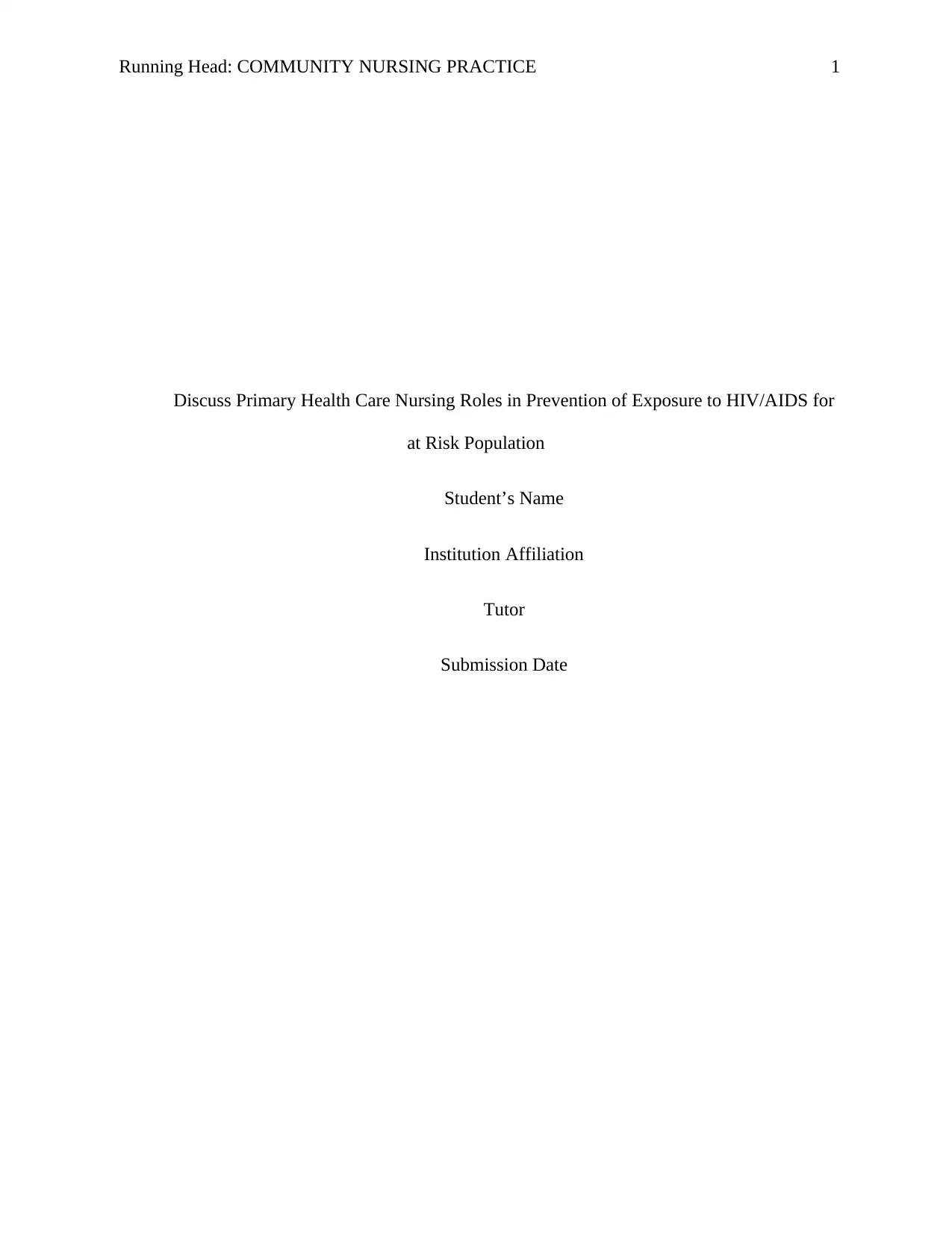
Running Head: COMMUNITY NURSING PRACTICE 1
Discuss Primary Health Care Nursing Roles in Prevention of Exposure to HIV/AIDS for
at Risk Population
Student’s Name
Institution Affiliation
Tutor
Submission Date
Discuss Primary Health Care Nursing Roles in Prevention of Exposure to HIV/AIDS for
at Risk Population
Student’s Name
Institution Affiliation
Tutor
Submission Date
Secure Best Marks with AI Grader
Need help grading? Try our AI Grader for instant feedback on your assignments.
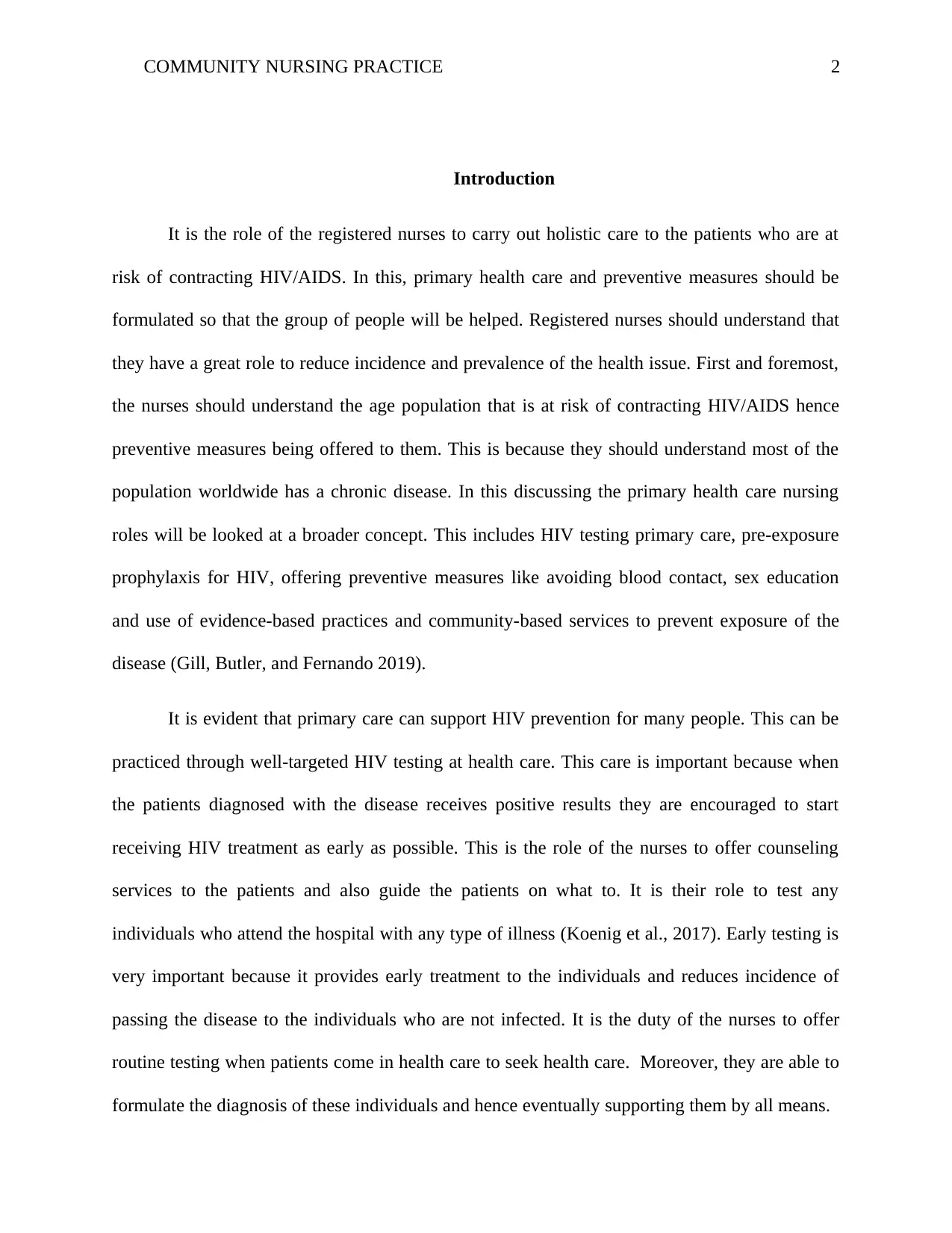
COMMUNITY NURSING PRACTICE 2
Introduction
It is the role of the registered nurses to carry out holistic care to the patients who are at
risk of contracting HIV/AIDS. In this, primary health care and preventive measures should be
formulated so that the group of people will be helped. Registered nurses should understand that
they have a great role to reduce incidence and prevalence of the health issue. First and foremost,
the nurses should understand the age population that is at risk of contracting HIV/AIDS hence
preventive measures being offered to them. This is because they should understand most of the
population worldwide has a chronic disease. In this discussing the primary health care nursing
roles will be looked at a broader concept. This includes HIV testing primary care, pre-exposure
prophylaxis for HIV, offering preventive measures like avoiding blood contact, sex education
and use of evidence-based practices and community-based services to prevent exposure of the
disease (Gill, Butler, and Fernando 2019).
It is evident that primary care can support HIV prevention for many people. This can be
practiced through well-targeted HIV testing at health care. This care is important because when
the patients diagnosed with the disease receives positive results they are encouraged to start
receiving HIV treatment as early as possible. This is the role of the nurses to offer counseling
services to the patients and also guide the patients on what to. It is their role to test any
individuals who attend the hospital with any type of illness (Koenig et al., 2017). Early testing is
very important because it provides early treatment to the individuals and reduces incidence of
passing the disease to the individuals who are not infected. It is the duty of the nurses to offer
routine testing when patients come in health care to seek health care. Moreover, they are able to
formulate the diagnosis of these individuals and hence eventually supporting them by all means.
Introduction
It is the role of the registered nurses to carry out holistic care to the patients who are at
risk of contracting HIV/AIDS. In this, primary health care and preventive measures should be
formulated so that the group of people will be helped. Registered nurses should understand that
they have a great role to reduce incidence and prevalence of the health issue. First and foremost,
the nurses should understand the age population that is at risk of contracting HIV/AIDS hence
preventive measures being offered to them. This is because they should understand most of the
population worldwide has a chronic disease. In this discussing the primary health care nursing
roles will be looked at a broader concept. This includes HIV testing primary care, pre-exposure
prophylaxis for HIV, offering preventive measures like avoiding blood contact, sex education
and use of evidence-based practices and community-based services to prevent exposure of the
disease (Gill, Butler, and Fernando 2019).
It is evident that primary care can support HIV prevention for many people. This can be
practiced through well-targeted HIV testing at health care. This care is important because when
the patients diagnosed with the disease receives positive results they are encouraged to start
receiving HIV treatment as early as possible. This is the role of the nurses to offer counseling
services to the patients and also guide the patients on what to. It is their role to test any
individuals who attend the hospital with any type of illness (Koenig et al., 2017). Early testing is
very important because it provides early treatment to the individuals and reduces incidence of
passing the disease to the individuals who are not infected. It is the duty of the nurses to offer
routine testing when patients come in health care to seek health care. Moreover, they are able to
formulate the diagnosis of these individuals and hence eventually supporting them by all means.

COMMUNITY NURSING PRACTICE 3
When performing testing to the individuals it is the role of the nurses to let them know
the importance of testing. Many individuals who at risk are very vulnerable and in this, they are
supposed to know the importance of the process. In this, they should know there some health
benefits out of this process when the disease is treated early. Moreover, it is the role of the nurses
to explain to them that when early treatment is performed through screening, the viral load
reduces and hence it’s not easy to infect others with the disease. Moreover, nurses are supposed
to expose them to risk factors like sexual intercourse and how to avoid transmission (Leber et al.,
2015).
Most people who are the risk of getting the infection have never been tested. It is the role
of the nurses to know the reason why the patients are avoiding to be tested knowing that the
process is essential. Main factors which prevent them from getting tested include the structural
barriers, lack to perceive a risk of infection, fear of stigma in the society, discrimination from
friends and relatives, lack of knowledge about the risk factors which may come due to failure of
being tested and fear (Barbee, 2015). All these factors happen to a great number of individuals
across the world. In that, it is the role of the nurses to talk to these people and educate them on
the importance of receiving primary care. Moreover, most of the health centers individuals pay
some amount of money so that they can get tested. This means the individuals lacking financial
resources will avoid visiting the health centers in fear that they will be charged, to promote
primary care testing the government in every country should make HIV/AIDS testing free so that
individuals can access the health care easily without any fear. Moreover, it is evident that when
individuals realize the importance of getting tested the prevalence of this disease will be reduced
(White, Walsh and Golin, 2015).
When performing testing to the individuals it is the role of the nurses to let them know
the importance of testing. Many individuals who at risk are very vulnerable and in this, they are
supposed to know the importance of the process. In this, they should know there some health
benefits out of this process when the disease is treated early. Moreover, it is the role of the nurses
to explain to them that when early treatment is performed through screening, the viral load
reduces and hence it’s not easy to infect others with the disease. Moreover, nurses are supposed
to expose them to risk factors like sexual intercourse and how to avoid transmission (Leber et al.,
2015).
Most people who are the risk of getting the infection have never been tested. It is the role
of the nurses to know the reason why the patients are avoiding to be tested knowing that the
process is essential. Main factors which prevent them from getting tested include the structural
barriers, lack to perceive a risk of infection, fear of stigma in the society, discrimination from
friends and relatives, lack of knowledge about the risk factors which may come due to failure of
being tested and fear (Barbee, 2015). All these factors happen to a great number of individuals
across the world. In that, it is the role of the nurses to talk to these people and educate them on
the importance of receiving primary care. Moreover, most of the health centers individuals pay
some amount of money so that they can get tested. This means the individuals lacking financial
resources will avoid visiting the health centers in fear that they will be charged, to promote
primary care testing the government in every country should make HIV/AIDS testing free so that
individuals can access the health care easily without any fear. Moreover, it is evident that when
individuals realize the importance of getting tested the prevalence of this disease will be reduced
(White, Walsh and Golin, 2015).
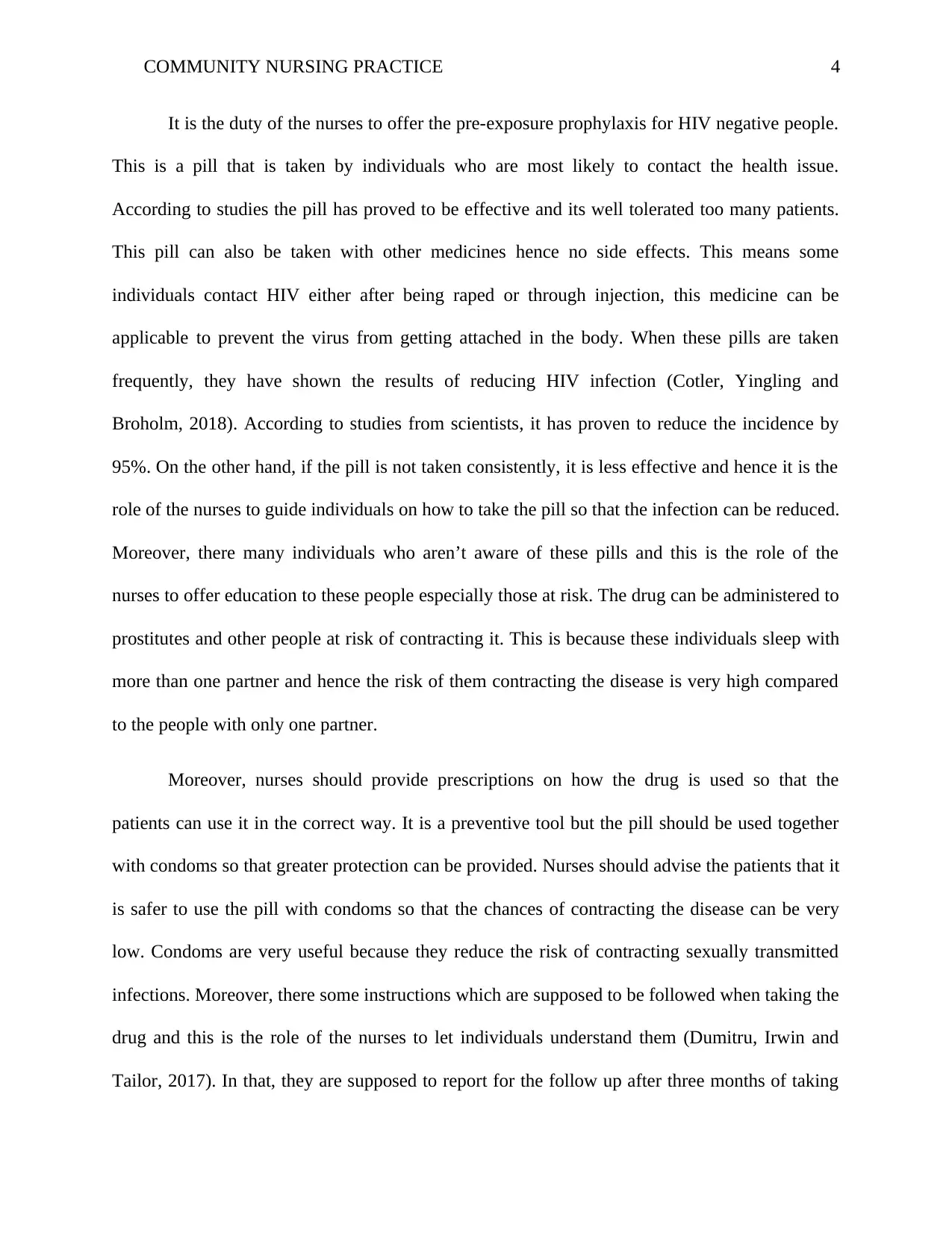
COMMUNITY NURSING PRACTICE 4
It is the duty of the nurses to offer the pre-exposure prophylaxis for HIV negative people.
This is a pill that is taken by individuals who are most likely to contact the health issue.
According to studies the pill has proved to be effective and its well tolerated too many patients.
This pill can also be taken with other medicines hence no side effects. This means some
individuals contact HIV either after being raped or through injection, this medicine can be
applicable to prevent the virus from getting attached in the body. When these pills are taken
frequently, they have shown the results of reducing HIV infection (Cotler, Yingling and
Broholm, 2018). According to studies from scientists, it has proven to reduce the incidence by
95%. On the other hand, if the pill is not taken consistently, it is less effective and hence it is the
role of the nurses to guide individuals on how to take the pill so that the infection can be reduced.
Moreover, there many individuals who aren’t aware of these pills and this is the role of the
nurses to offer education to these people especially those at risk. The drug can be administered to
prostitutes and other people at risk of contracting it. This is because these individuals sleep with
more than one partner and hence the risk of them contracting the disease is very high compared
to the people with only one partner.
Moreover, nurses should provide prescriptions on how the drug is used so that the
patients can use it in the correct way. It is a preventive tool but the pill should be used together
with condoms so that greater protection can be provided. Nurses should advise the patients that it
is safer to use the pill with condoms so that the chances of contracting the disease can be very
low. Condoms are very useful because they reduce the risk of contracting sexually transmitted
infections. Moreover, there some instructions which are supposed to be followed when taking the
drug and this is the role of the nurses to let individuals understand them (Dumitru, Irwin and
Tailor, 2017). In that, they are supposed to report for the follow up after three months of taking
It is the duty of the nurses to offer the pre-exposure prophylaxis for HIV negative people.
This is a pill that is taken by individuals who are most likely to contact the health issue.
According to studies the pill has proved to be effective and its well tolerated too many patients.
This pill can also be taken with other medicines hence no side effects. This means some
individuals contact HIV either after being raped or through injection, this medicine can be
applicable to prevent the virus from getting attached in the body. When these pills are taken
frequently, they have shown the results of reducing HIV infection (Cotler, Yingling and
Broholm, 2018). According to studies from scientists, it has proven to reduce the incidence by
95%. On the other hand, if the pill is not taken consistently, it is less effective and hence it is the
role of the nurses to guide individuals on how to take the pill so that the infection can be reduced.
Moreover, there many individuals who aren’t aware of these pills and this is the role of the
nurses to offer education to these people especially those at risk. The drug can be administered to
prostitutes and other people at risk of contracting it. This is because these individuals sleep with
more than one partner and hence the risk of them contracting the disease is very high compared
to the people with only one partner.
Moreover, nurses should provide prescriptions on how the drug is used so that the
patients can use it in the correct way. It is a preventive tool but the pill should be used together
with condoms so that greater protection can be provided. Nurses should advise the patients that it
is safer to use the pill with condoms so that the chances of contracting the disease can be very
low. Condoms are very useful because they reduce the risk of contracting sexually transmitted
infections. Moreover, there some instructions which are supposed to be followed when taking the
drug and this is the role of the nurses to let individuals understand them (Dumitru, Irwin and
Tailor, 2017). In that, they are supposed to report for the follow up after three months of taking
Secure Best Marks with AI Grader
Need help grading? Try our AI Grader for instant feedback on your assignments.
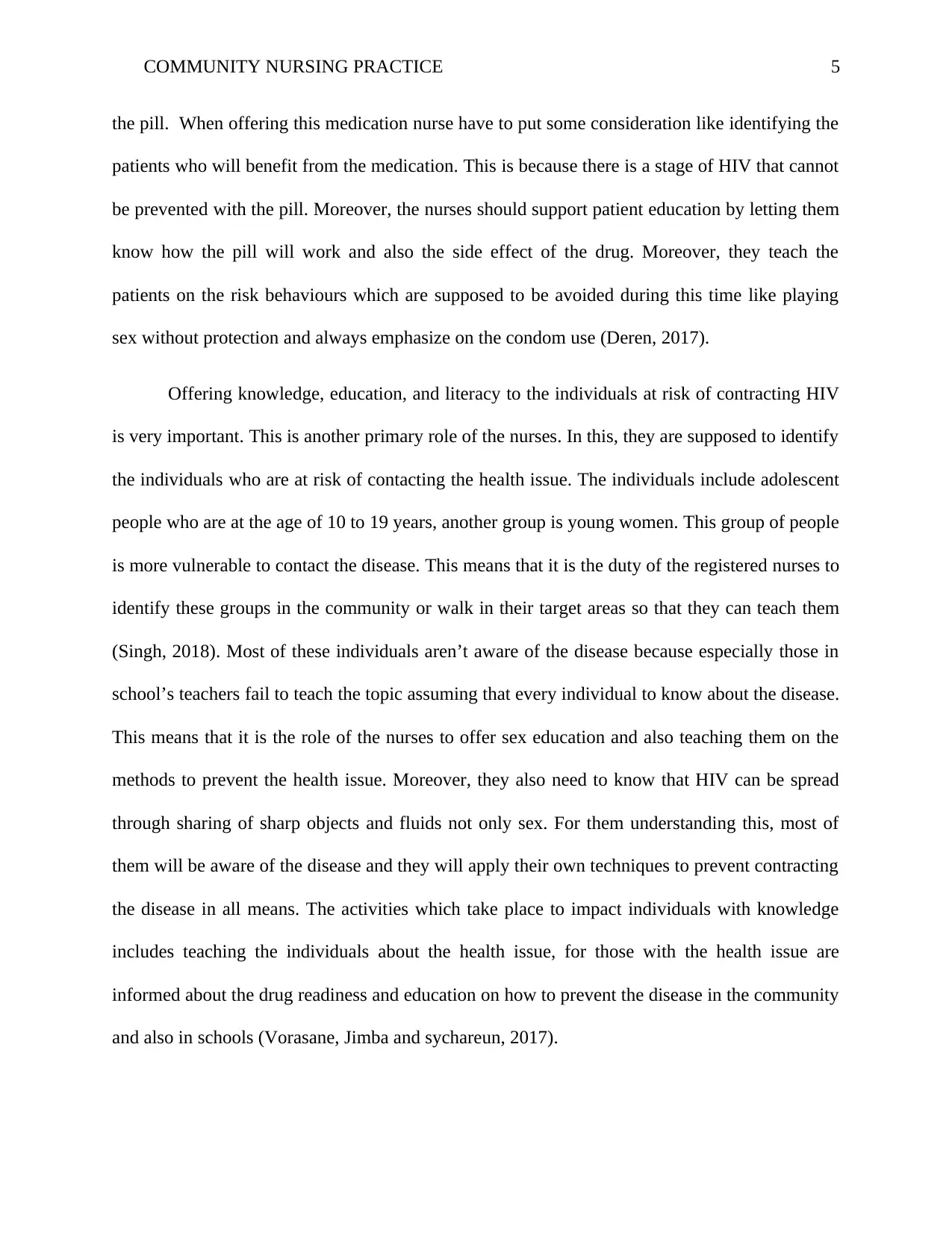
COMMUNITY NURSING PRACTICE 5
the pill. When offering this medication nurse have to put some consideration like identifying the
patients who will benefit from the medication. This is because there is a stage of HIV that cannot
be prevented with the pill. Moreover, the nurses should support patient education by letting them
know how the pill will work and also the side effect of the drug. Moreover, they teach the
patients on the risk behaviours which are supposed to be avoided during this time like playing
sex without protection and always emphasize on the condom use (Deren, 2017).
Offering knowledge, education, and literacy to the individuals at risk of contracting HIV
is very important. This is another primary role of the nurses. In this, they are supposed to identify
the individuals who are at risk of contacting the health issue. The individuals include adolescent
people who are at the age of 10 to 19 years, another group is young women. This group of people
is more vulnerable to contact the disease. This means that it is the duty of the registered nurses to
identify these groups in the community or walk in their target areas so that they can teach them
(Singh, 2018). Most of these individuals aren’t aware of the disease because especially those in
school’s teachers fail to teach the topic assuming that every individual to know about the disease.
This means that it is the role of the nurses to offer sex education and also teaching them on the
methods to prevent the health issue. Moreover, they also need to know that HIV can be spread
through sharing of sharp objects and fluids not only sex. For them understanding this, most of
them will be aware of the disease and they will apply their own techniques to prevent contracting
the disease in all means. The activities which take place to impact individuals with knowledge
includes teaching the individuals about the health issue, for those with the health issue are
informed about the drug readiness and education on how to prevent the disease in the community
and also in schools (Vorasane, Jimba and sychareun, 2017).
the pill. When offering this medication nurse have to put some consideration like identifying the
patients who will benefit from the medication. This is because there is a stage of HIV that cannot
be prevented with the pill. Moreover, the nurses should support patient education by letting them
know how the pill will work and also the side effect of the drug. Moreover, they teach the
patients on the risk behaviours which are supposed to be avoided during this time like playing
sex without protection and always emphasize on the condom use (Deren, 2017).
Offering knowledge, education, and literacy to the individuals at risk of contracting HIV
is very important. This is another primary role of the nurses. In this, they are supposed to identify
the individuals who are at risk of contacting the health issue. The individuals include adolescent
people who are at the age of 10 to 19 years, another group is young women. This group of people
is more vulnerable to contact the disease. This means that it is the duty of the registered nurses to
identify these groups in the community or walk in their target areas so that they can teach them
(Singh, 2018). Most of these individuals aren’t aware of the disease because especially those in
school’s teachers fail to teach the topic assuming that every individual to know about the disease.
This means that it is the role of the nurses to offer sex education and also teaching them on the
methods to prevent the health issue. Moreover, they also need to know that HIV can be spread
through sharing of sharp objects and fluids not only sex. For them understanding this, most of
them will be aware of the disease and they will apply their own techniques to prevent contracting
the disease in all means. The activities which take place to impact individuals with knowledge
includes teaching the individuals about the health issue, for those with the health issue are
informed about the drug readiness and education on how to prevent the disease in the community
and also in schools (Vorasane, Jimba and sychareun, 2017).
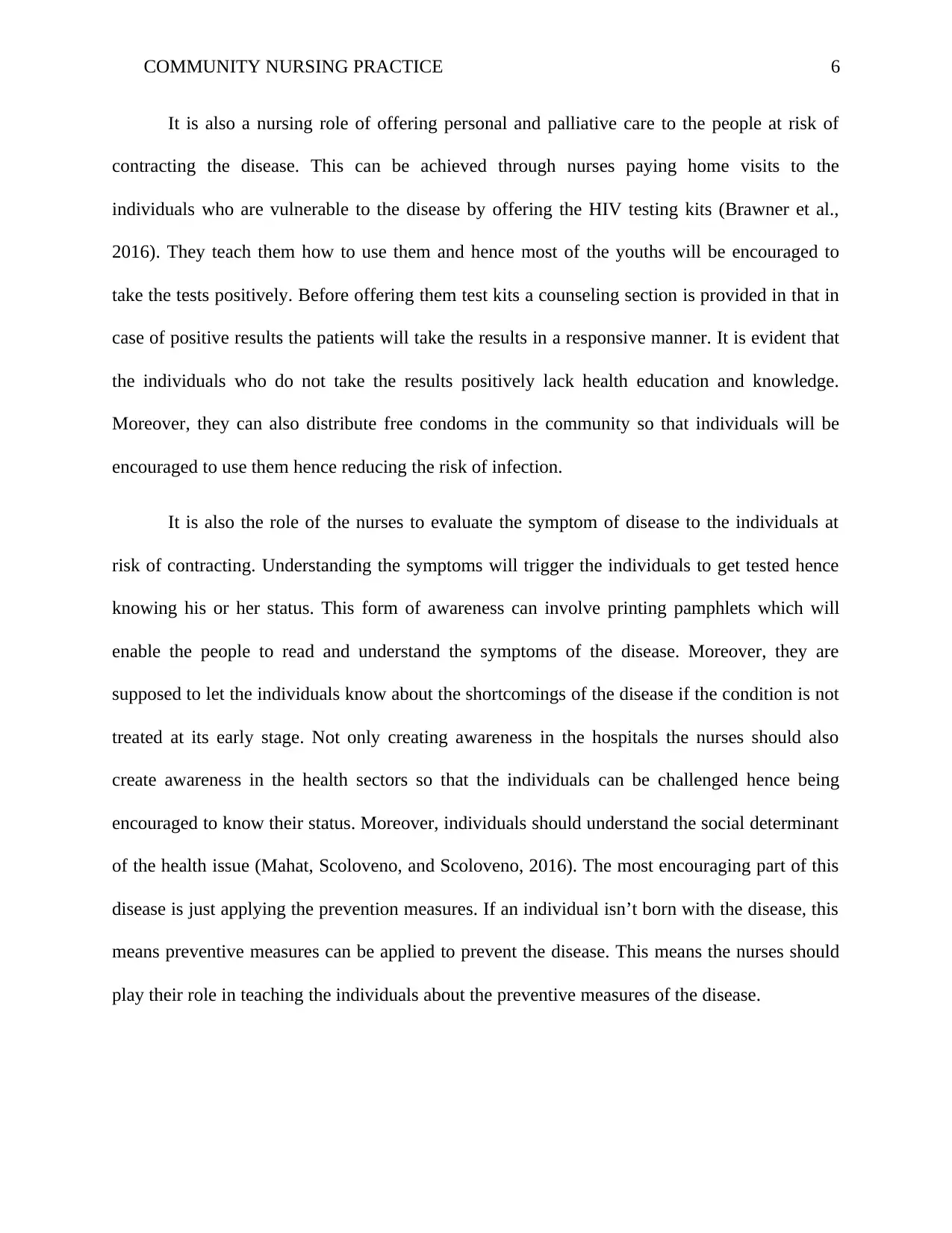
COMMUNITY NURSING PRACTICE 6
It is also a nursing role of offering personal and palliative care to the people at risk of
contracting the disease. This can be achieved through nurses paying home visits to the
individuals who are vulnerable to the disease by offering the HIV testing kits (Brawner et al.,
2016). They teach them how to use them and hence most of the youths will be encouraged to
take the tests positively. Before offering them test kits a counseling section is provided in that in
case of positive results the patients will take the results in a responsive manner. It is evident that
the individuals who do not take the results positively lack health education and knowledge.
Moreover, they can also distribute free condoms in the community so that individuals will be
encouraged to use them hence reducing the risk of infection.
It is also the role of the nurses to evaluate the symptom of disease to the individuals at
risk of contracting. Understanding the symptoms will trigger the individuals to get tested hence
knowing his or her status. This form of awareness can involve printing pamphlets which will
enable the people to read and understand the symptoms of the disease. Moreover, they are
supposed to let the individuals know about the shortcomings of the disease if the condition is not
treated at its early stage. Not only creating awareness in the hospitals the nurses should also
create awareness in the health sectors so that the individuals can be challenged hence being
encouraged to know their status. Moreover, individuals should understand the social determinant
of the health issue (Mahat, Scoloveno, and Scoloveno, 2016). The most encouraging part of this
disease is just applying the prevention measures. If an individual isn’t born with the disease, this
means preventive measures can be applied to prevent the disease. This means the nurses should
play their role in teaching the individuals about the preventive measures of the disease.
It is also a nursing role of offering personal and palliative care to the people at risk of
contracting the disease. This can be achieved through nurses paying home visits to the
individuals who are vulnerable to the disease by offering the HIV testing kits (Brawner et al.,
2016). They teach them how to use them and hence most of the youths will be encouraged to
take the tests positively. Before offering them test kits a counseling section is provided in that in
case of positive results the patients will take the results in a responsive manner. It is evident that
the individuals who do not take the results positively lack health education and knowledge.
Moreover, they can also distribute free condoms in the community so that individuals will be
encouraged to use them hence reducing the risk of infection.
It is also the role of the nurses to evaluate the symptom of disease to the individuals at
risk of contracting. Understanding the symptoms will trigger the individuals to get tested hence
knowing his or her status. This form of awareness can involve printing pamphlets which will
enable the people to read and understand the symptoms of the disease. Moreover, they are
supposed to let the individuals know about the shortcomings of the disease if the condition is not
treated at its early stage. Not only creating awareness in the hospitals the nurses should also
create awareness in the health sectors so that the individuals can be challenged hence being
encouraged to know their status. Moreover, individuals should understand the social determinant
of the health issue (Mahat, Scoloveno, and Scoloveno, 2016). The most encouraging part of this
disease is just applying the prevention measures. If an individual isn’t born with the disease, this
means preventive measures can be applied to prevent the disease. This means the nurses should
play their role in teaching the individuals about the preventive measures of the disease.
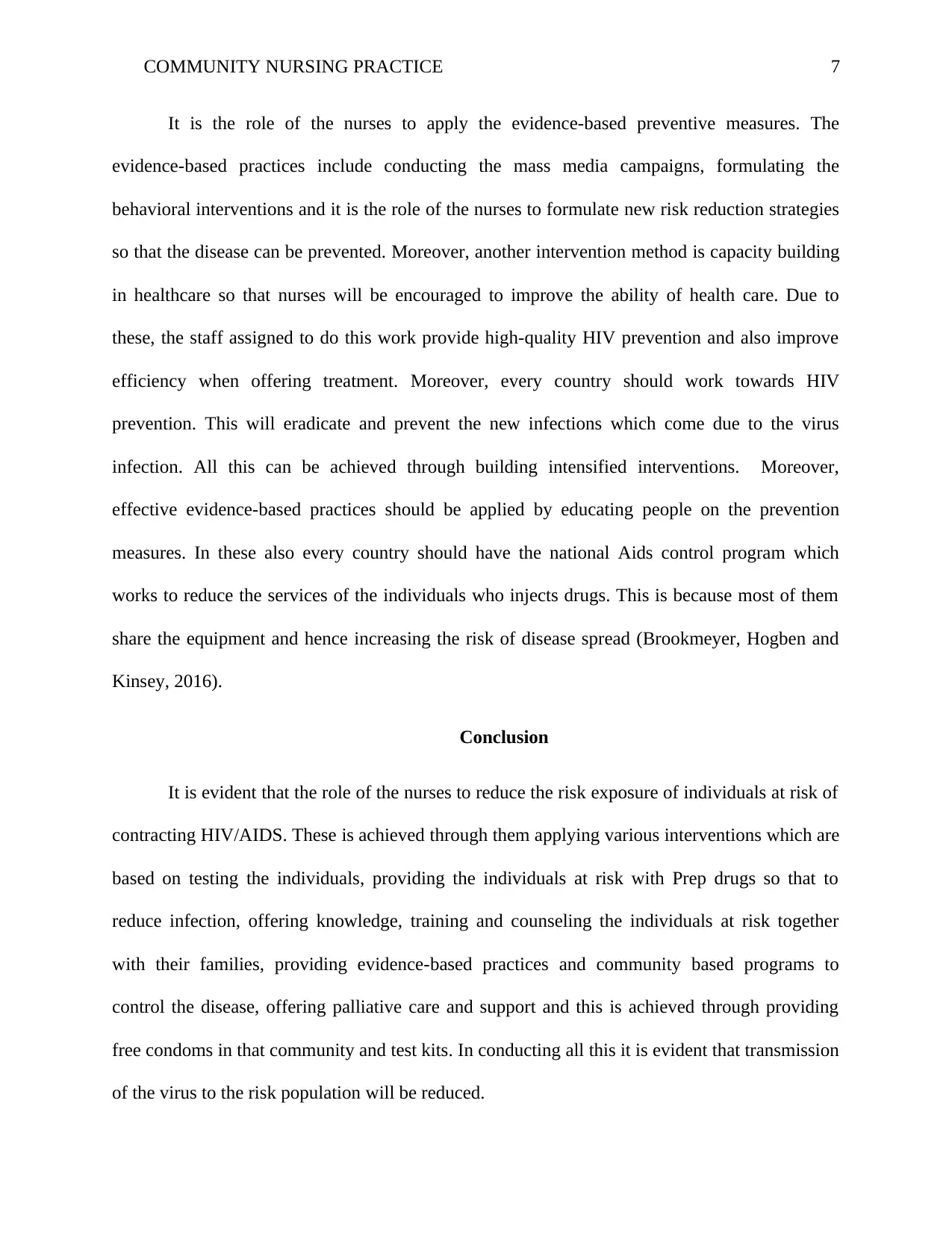
COMMUNITY NURSING PRACTICE 7
It is the role of the nurses to apply the evidence-based preventive measures. The
evidence-based practices include conducting the mass media campaigns, formulating the
behavioral interventions and it is the role of the nurses to formulate new risk reduction strategies
so that the disease can be prevented. Moreover, another intervention method is capacity building
in healthcare so that nurses will be encouraged to improve the ability of health care. Due to
these, the staff assigned to do this work provide high-quality HIV prevention and also improve
efficiency when offering treatment. Moreover, every country should work towards HIV
prevention. This will eradicate and prevent the new infections which come due to the virus
infection. All this can be achieved through building intensified interventions. Moreover,
effective evidence-based practices should be applied by educating people on the prevention
measures. In these also every country should have the national Aids control program which
works to reduce the services of the individuals who injects drugs. This is because most of them
share the equipment and hence increasing the risk of disease spread (Brookmeyer, Hogben and
Kinsey, 2016).
Conclusion
It is evident that the role of the nurses to reduce the risk exposure of individuals at risk of
contracting HIV/AIDS. These is achieved through them applying various interventions which are
based on testing the individuals, providing the individuals at risk with Prep drugs so that to
reduce infection, offering knowledge, training and counseling the individuals at risk together
with their families, providing evidence-based practices and community based programs to
control the disease, offering palliative care and support and this is achieved through providing
free condoms in that community and test kits. In conducting all this it is evident that transmission
of the virus to the risk population will be reduced.
It is the role of the nurses to apply the evidence-based preventive measures. The
evidence-based practices include conducting the mass media campaigns, formulating the
behavioral interventions and it is the role of the nurses to formulate new risk reduction strategies
so that the disease can be prevented. Moreover, another intervention method is capacity building
in healthcare so that nurses will be encouraged to improve the ability of health care. Due to
these, the staff assigned to do this work provide high-quality HIV prevention and also improve
efficiency when offering treatment. Moreover, every country should work towards HIV
prevention. This will eradicate and prevent the new infections which come due to the virus
infection. All this can be achieved through building intensified interventions. Moreover,
effective evidence-based practices should be applied by educating people on the prevention
measures. In these also every country should have the national Aids control program which
works to reduce the services of the individuals who injects drugs. This is because most of them
share the equipment and hence increasing the risk of disease spread (Brookmeyer, Hogben and
Kinsey, 2016).
Conclusion
It is evident that the role of the nurses to reduce the risk exposure of individuals at risk of
contracting HIV/AIDS. These is achieved through them applying various interventions which are
based on testing the individuals, providing the individuals at risk with Prep drugs so that to
reduce infection, offering knowledge, training and counseling the individuals at risk together
with their families, providing evidence-based practices and community based programs to
control the disease, offering palliative care and support and this is achieved through providing
free condoms in that community and test kits. In conducting all this it is evident that transmission
of the virus to the risk population will be reduced.
Paraphrase This Document
Need a fresh take? Get an instant paraphrase of this document with our AI Paraphraser

COMMUNITY NURSING PRACTICE 8
References
References
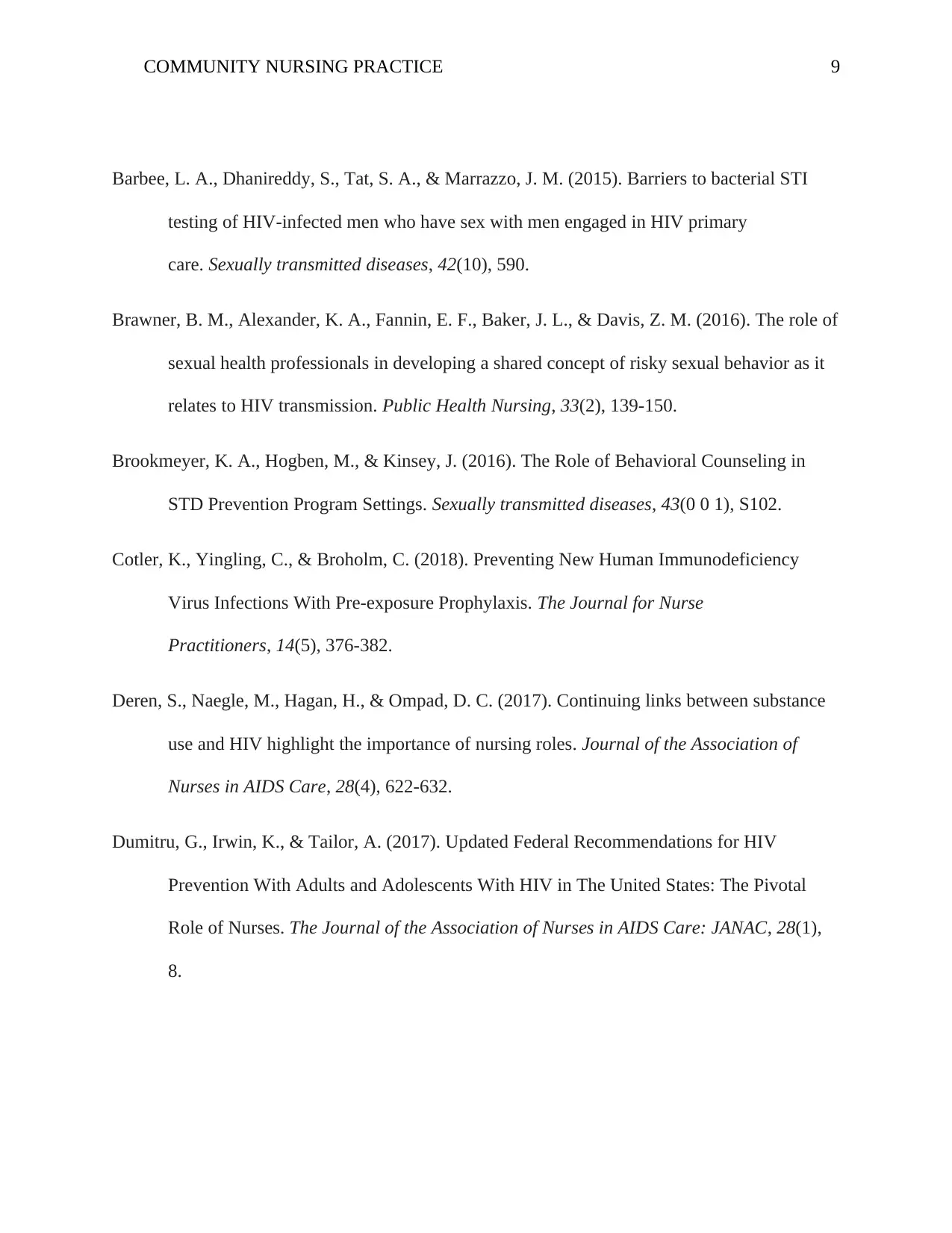
COMMUNITY NURSING PRACTICE 9
Barbee, L. A., Dhanireddy, S., Tat, S. A., & Marrazzo, J. M. (2015). Barriers to bacterial STI
testing of HIV-infected men who have sex with men engaged in HIV primary
care. Sexually transmitted diseases, 42(10), 590.
Brawner, B. M., Alexander, K. A., Fannin, E. F., Baker, J. L., & Davis, Z. M. (2016). The role of
sexual health professionals in developing a shared concept of risky sexual behavior as it
relates to HIV transmission. Public Health Nursing, 33(2), 139-150.
Brookmeyer, K. A., Hogben, M., & Kinsey, J. (2016). The Role of Behavioral Counseling in
STD Prevention Program Settings. Sexually transmitted diseases, 43(0 0 1), S102.
Cotler, K., Yingling, C., & Broholm, C. (2018). Preventing New Human Immunodeficiency
Virus Infections With Pre-exposure Prophylaxis. The Journal for Nurse
Practitioners, 14(5), 376-382.
Deren, S., Naegle, M., Hagan, H., & Ompad, D. C. (2017). Continuing links between substance
use and HIV highlight the importance of nursing roles. Journal of the Association of
Nurses in AIDS Care, 28(4), 622-632.
Dumitru, G., Irwin, K., & Tailor, A. (2017). Updated Federal Recommendations for HIV
Prevention With Adults and Adolescents With HIV in The United States: The Pivotal
Role of Nurses. The Journal of the Association of Nurses in AIDS Care: JANAC, 28(1),
8.
Barbee, L. A., Dhanireddy, S., Tat, S. A., & Marrazzo, J. M. (2015). Barriers to bacterial STI
testing of HIV-infected men who have sex with men engaged in HIV primary
care. Sexually transmitted diseases, 42(10), 590.
Brawner, B. M., Alexander, K. A., Fannin, E. F., Baker, J. L., & Davis, Z. M. (2016). The role of
sexual health professionals in developing a shared concept of risky sexual behavior as it
relates to HIV transmission. Public Health Nursing, 33(2), 139-150.
Brookmeyer, K. A., Hogben, M., & Kinsey, J. (2016). The Role of Behavioral Counseling in
STD Prevention Program Settings. Sexually transmitted diseases, 43(0 0 1), S102.
Cotler, K., Yingling, C., & Broholm, C. (2018). Preventing New Human Immunodeficiency
Virus Infections With Pre-exposure Prophylaxis. The Journal for Nurse
Practitioners, 14(5), 376-382.
Deren, S., Naegle, M., Hagan, H., & Ompad, D. C. (2017). Continuing links between substance
use and HIV highlight the importance of nursing roles. Journal of the Association of
Nurses in AIDS Care, 28(4), 622-632.
Dumitru, G., Irwin, K., & Tailor, A. (2017). Updated Federal Recommendations for HIV
Prevention With Adults and Adolescents With HIV in The United States: The Pivotal
Role of Nurses. The Journal of the Association of Nurses in AIDS Care: JANAC, 28(1),
8.
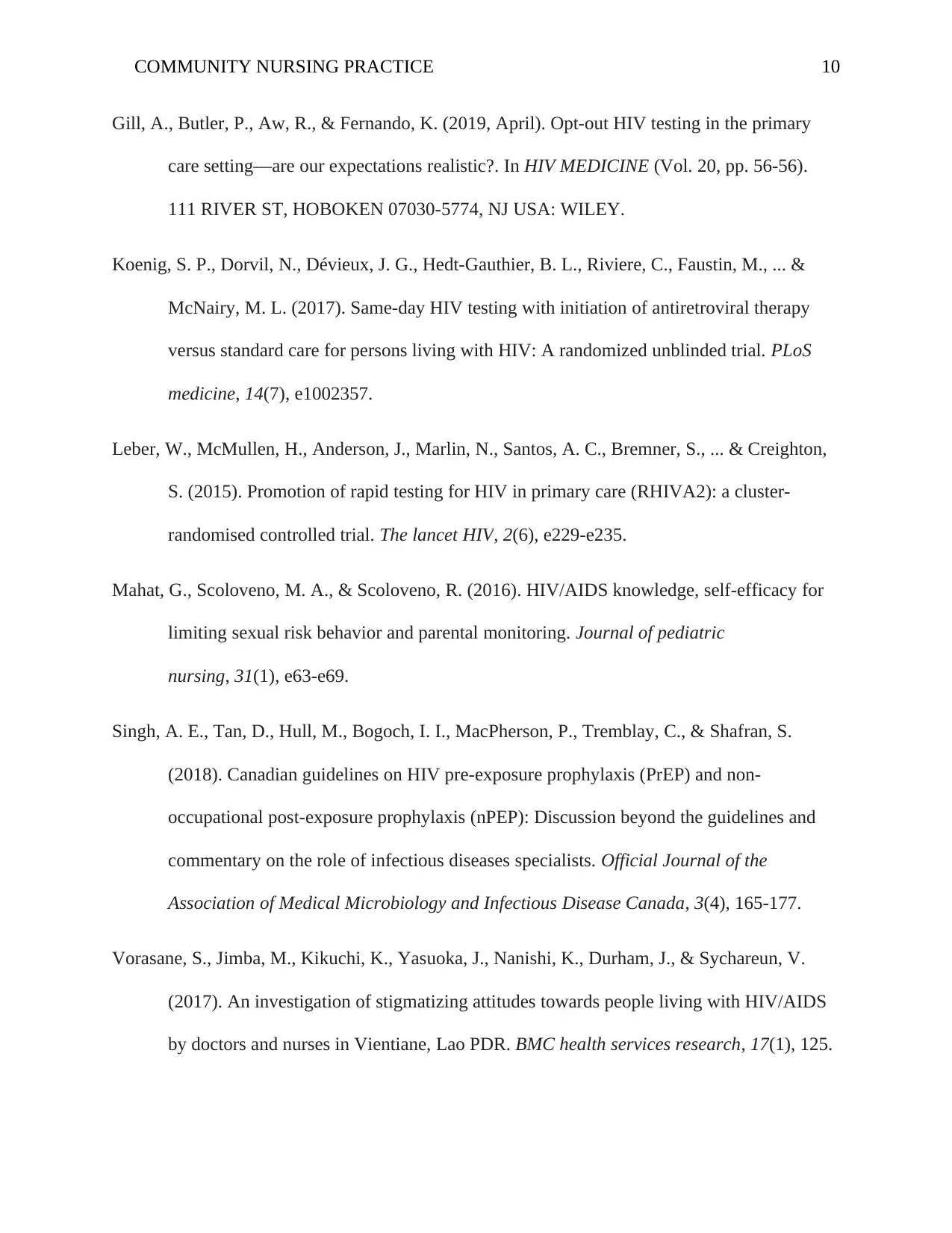
COMMUNITY NURSING PRACTICE 10
Gill, A., Butler, P., Aw, R., & Fernando, K. (2019, April). Opt-out HIV testing in the primary
care setting—are our expectations realistic?. In HIV MEDICINE (Vol. 20, pp. 56-56).
111 RIVER ST, HOBOKEN 07030-5774, NJ USA: WILEY.
Koenig, S. P., Dorvil, N., Dévieux, J. G., Hedt-Gauthier, B. L., Riviere, C., Faustin, M., ... &
McNairy, M. L. (2017). Same-day HIV testing with initiation of antiretroviral therapy
versus standard care for persons living with HIV: A randomized unblinded trial. PLoS
medicine, 14(7), e1002357.
Leber, W., McMullen, H., Anderson, J., Marlin, N., Santos, A. C., Bremner, S., ... & Creighton,
S. (2015). Promotion of rapid testing for HIV in primary care (RHIVA2): a cluster-
randomised controlled trial. The lancet HIV, 2(6), e229-e235.
Mahat, G., Scoloveno, M. A., & Scoloveno, R. (2016). HIV/AIDS knowledge, self-efficacy for
limiting sexual risk behavior and parental monitoring. Journal of pediatric
nursing, 31(1), e63-e69.
Singh, A. E., Tan, D., Hull, M., Bogoch, I. I., MacPherson, P., Tremblay, C., & Shafran, S.
(2018). Canadian guidelines on HIV pre-exposure prophylaxis (PrEP) and non-
occupational post-exposure prophylaxis (nPEP): Discussion beyond the guidelines and
commentary on the role of infectious diseases specialists. Official Journal of the
Association of Medical Microbiology and Infectious Disease Canada, 3(4), 165-177.
Vorasane, S., Jimba, M., Kikuchi, K., Yasuoka, J., Nanishi, K., Durham, J., & Sychareun, V.
(2017). An investigation of stigmatizing attitudes towards people living with HIV/AIDS
by doctors and nurses in Vientiane, Lao PDR. BMC health services research, 17(1), 125.
Gill, A., Butler, P., Aw, R., & Fernando, K. (2019, April). Opt-out HIV testing in the primary
care setting—are our expectations realistic?. In HIV MEDICINE (Vol. 20, pp. 56-56).
111 RIVER ST, HOBOKEN 07030-5774, NJ USA: WILEY.
Koenig, S. P., Dorvil, N., Dévieux, J. G., Hedt-Gauthier, B. L., Riviere, C., Faustin, M., ... &
McNairy, M. L. (2017). Same-day HIV testing with initiation of antiretroviral therapy
versus standard care for persons living with HIV: A randomized unblinded trial. PLoS
medicine, 14(7), e1002357.
Leber, W., McMullen, H., Anderson, J., Marlin, N., Santos, A. C., Bremner, S., ... & Creighton,
S. (2015). Promotion of rapid testing for HIV in primary care (RHIVA2): a cluster-
randomised controlled trial. The lancet HIV, 2(6), e229-e235.
Mahat, G., Scoloveno, M. A., & Scoloveno, R. (2016). HIV/AIDS knowledge, self-efficacy for
limiting sexual risk behavior and parental monitoring. Journal of pediatric
nursing, 31(1), e63-e69.
Singh, A. E., Tan, D., Hull, M., Bogoch, I. I., MacPherson, P., Tremblay, C., & Shafran, S.
(2018). Canadian guidelines on HIV pre-exposure prophylaxis (PrEP) and non-
occupational post-exposure prophylaxis (nPEP): Discussion beyond the guidelines and
commentary on the role of infectious diseases specialists. Official Journal of the
Association of Medical Microbiology and Infectious Disease Canada, 3(4), 165-177.
Vorasane, S., Jimba, M., Kikuchi, K., Yasuoka, J., Nanishi, K., Durham, J., & Sychareun, V.
(2017). An investigation of stigmatizing attitudes towards people living with HIV/AIDS
by doctors and nurses in Vientiane, Lao PDR. BMC health services research, 17(1), 125.
Secure Best Marks with AI Grader
Need help grading? Try our AI Grader for instant feedback on your assignments.
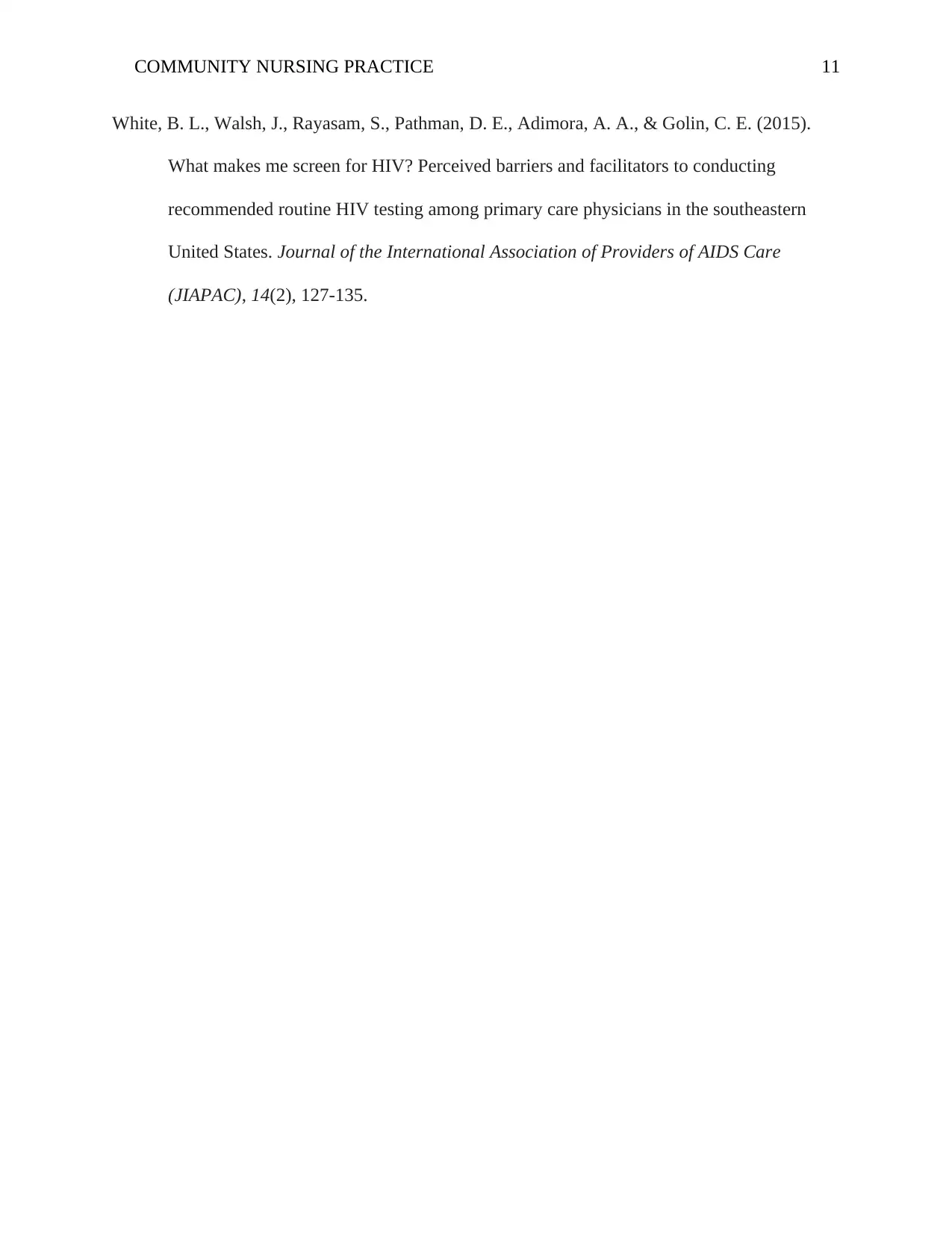
COMMUNITY NURSING PRACTICE 11
White, B. L., Walsh, J., Rayasam, S., Pathman, D. E., Adimora, A. A., & Golin, C. E. (2015).
What makes me screen for HIV? Perceived barriers and facilitators to conducting
recommended routine HIV testing among primary care physicians in the southeastern
United States. Journal of the International Association of Providers of AIDS Care
(JIAPAC), 14(2), 127-135.
White, B. L., Walsh, J., Rayasam, S., Pathman, D. E., Adimora, A. A., & Golin, C. E. (2015).
What makes me screen for HIV? Perceived barriers and facilitators to conducting
recommended routine HIV testing among primary care physicians in the southeastern
United States. Journal of the International Association of Providers of AIDS Care
(JIAPAC), 14(2), 127-135.
1 out of 11
Related Documents
Your All-in-One AI-Powered Toolkit for Academic Success.
+13062052269
info@desklib.com
Available 24*7 on WhatsApp / Email
![[object Object]](/_next/static/media/star-bottom.7253800d.svg)
Unlock your academic potential
© 2024 | Zucol Services PVT LTD | All rights reserved.





